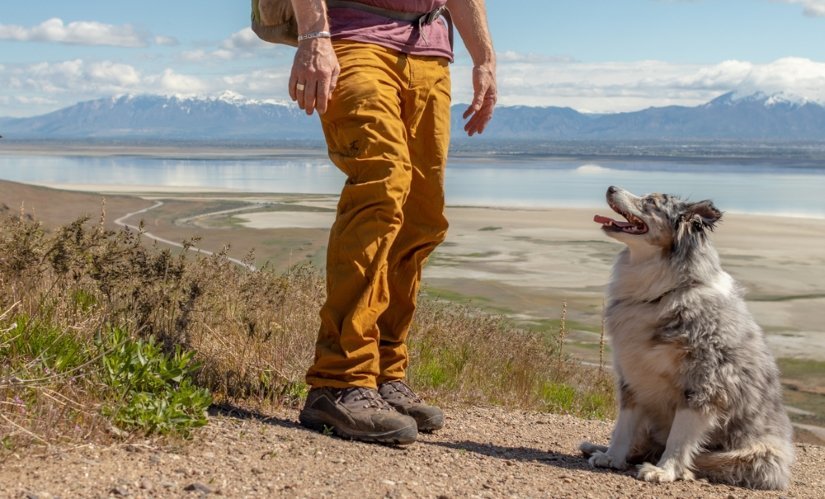Are you planning on traveling with dogs and wondering how to get them to your destination without it being one hell of a job? Well, we got you. After researching here is a detailed guide on getting the job done quickly and without a sigh!
Crates
As someone who is going to be moving from one location to another until you reach your destination, a crate for your paw friend is essential. With them, you can keep your canine safe from trouble in the controlled environment it provides. You can also place your furry friend safely in the car, bus, or any other vehicle. These pet travel crates come in handy during air travels and help keep things cool when you decide to check in a hotel or visit someone with your dog.
If you are interested in locating a nice place to purchase your dog’s pet travel crate, you can check out both online and local stores. However, while on it, there are some features you need to keep in mind:
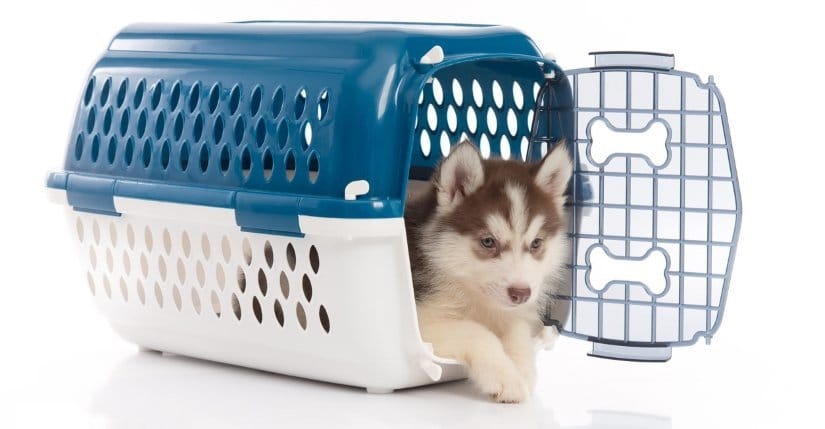
Preferred crate:
- Your ideal crate shouldn’t have inside protrusion to keep your dog safe.
- Should be strong and have firm handles with good grips for easy carrying.
- The right crate should have a leak-proof, absorbing bottom to take in sweat and spills without showing it on the other side.
- The crate should be broad and tall enough for your dog to move around and lie down.
- Your ideal crate should have two ventilation system on opposing sides to ensure the free flow of air.
- It should also house its rims and knobs outside.
Other things you want to put in place in your new crate is an arrow by the side, facing up with a label that says something like, “Live Animal”. This gives bystanders an idea of what is inside. You should also add your name and address next to the arrow and label. This will really come in handy if somehow, you manage to misplace your furry-ball’s crate.
Another tip we have for you is making sure you have your dog’s favorite toys and a comfy mat inside the crate. It will help them remain occupied during the journey, and that’s why we recommended that your ideal pet travel crate be large enough for the dog to stand and move around.
Identification
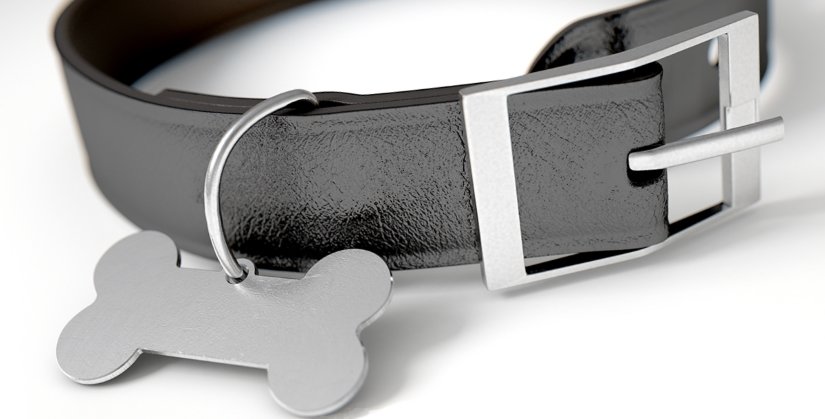
As someone travelling with dogs, surely the thrill of the moment might cloud you from seeing it coming— the chances of your dog running off into an unknown destination, which leaves you searching for the canine with sometimes little success. To avoid such occurrence, it is essential that along with your hiking, camping or travel luggage, that you have your furry friend’s identification information. They will surely help you make it easier to be reunited with your pet. Here are some of those you should not forget at home:
Things to bring along with you:
- Before leaving, you can take a picture of your pet and also come with a recent hardcopy photo if any. It will allow you to show them off to friends and strangers who might have seen him or her running off.
- Along with that, bring with you, his or her recent health document showing their full vaccination.
- You should not forget to buy a rigid collar for your paw friend. If you don’t have one or are considering purchasing a new one but have no idea where to get the best for him or her, check this out. Ensure that your preferred collar has an identification tag where you can place your dog’s name, your name, your address, your phone number and even the rabies status of your furry ball. If you are going for a mini travel in the travel without your pet, you should also have a second collar that bears the name of the place you will be going to and your phone number.
- You can also put a tracker on your dog by implanting a microchip on him or her. This will always allow you to know where your loyal companion is at all times.
Health And Safety

As you are taking your dog to another place across states, in the woods, or over the ocean, you will be exposing the canine to an unfamiliar environment. Hence, it is wise for you to ensure the safety of your furry friend to avoid any health hazard. Here is a checklist to cover before the trip:
Checklist:
- Have an appointment with the veterinarian. You don’t want to go on an extended trip with your canine friend missing a few of his shots. Ensure that he or she takes all their medications before leaving. While at it, it is good to discuss your travel with the vet for any other expert advice that concerns him or her.
- Place all medical document in the bag. Depending on the kind of transportation you decide to use for your travel, your pet might need all or most of his or her health documents present and updated to show to the transport authorities before they are allowed on board.
- Bring his or her favorite food and water. Don’t forget to pack enough food for your canine. Yes, you might have it in mind to purchase some when you get to your desired location for interstate or international travel. But it is wise however to go prepared. This way, your dog won’t run into issues of hunger and health deterioration. You can check online and offline for dry and wet dog foods to purchase. While at it, ensure to bring enough water for the journey so your furry buddy can remain hydrated and in his or her top performance.
- Bag the medication. If your dog is on med, it is wise not to leave the drugs at home while you travel with your canine friend. Ensure it is packed in the bag before you step out.
- Get the medical covered. Before the day of your departure check that you have your dog’s emergency first aid kit ready with all the needed supply. Also, get the numbers of the 24/7 emergency vet that is close to your vacation destination. Another thing you want to do is to ensure you have your current vet’s emergency number. This will come in handy when both specialists wish to speak, or you can’t reach the hospital on time.
- Pack all Furry’s equipment into the luggage. It is essential to secure the materials your canine needs for where he or she is going. Is it going to snow there? Are you going hiking or into the woods for camping? Is there stuff you need to get to ensure the best conditions for your furry pet? These are questions you need to have answered with the required supplies ready before you leave.
Along with all these, will like to drop with you a health tip. Keep your dog adequately exercised and on time irrespective of the place you are heading. It will enable the ball of furry joy to remain active, easily adapt, happy and healthy.
Traveling By Car
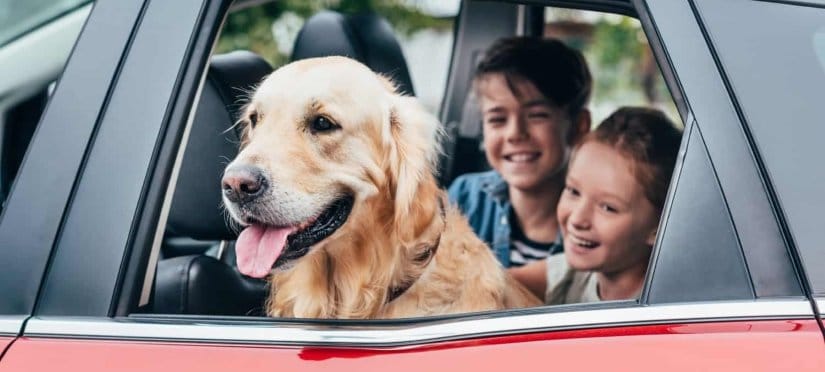
Traveling with dogs via automobile can be fun. But that is mostly if the dog isn’t anxious. If you own a canine that is afraid of vehicles due to, he or she hasn’t been in one, or the times you take them for a ride in your car is to the vet they don’t like, now is the time to work on your furry joy’s mind. You can do that by either sitting for a while with your dog in the car or taking him or her to fun locations. Here is a checklist to observe before the travel:
Checklist:
- Have the list of stops in your phone. Before leaving, calculate the number of hours it will take, and plan stops to allow your pet friend to relieve himself, stretch, and eat. A suitable stop interval should be three to four hours.
- Research the nearest vet on your path. Map out the right route you want to follow. Preferably, it should be the one with a good number of veterinarian facilities an hour away at various points of the journey. Get their contacts saved on your device and embark the trip during the period they will be open.
- Place Furry’s leash, toys, treats, seatbelt or crate in the car. They will most likely come in handy in various parts of your journey.
- Waste bag, blanket and dog bed. Surely, with these tagging along, both you and the pet can enjoy your time on the road. So, before leaving, ensure that you have checked if they are in the car with you.
- Take the medication & records, water, and bowl. If your dog is on med, bring along the medicine to ensure they don’t miss the schedule. The bowls will help you feed him or her their meal and water easily without getting you super wet.
Flying

Are you considering a flight with your dogs tagging along? You have got a nice idea, but most times the reality isn’t. For the majority of airlines, you will have to place your pet friend in the cargo section which isn’t really exciting. However, there are exceptions. Some flights allow you to sit your four-legged friend next to you if he or she is small, in a carrier, and can fit under your seat. You may even have the approval to allow them to sit next to the window to view the sky as the plane flies. Regardless of which choices you have, here are some points you need to get checked before leaving:
Checklist:
- Keep Paw friend healthy. A few weeks before you embark on your journey, meet up with the vet and be sure that your pet friend is 100% healthy. Also, that he or she has their vaccination and rabies certificates. The airline will be asking for those, and you should be able to send them about 10 days before the journey begins.
- Know the best way to fly your canine friend. Should he or she be sleeping or awake? Based on their anxiety level. This is something you need to go over with your vet. Also, ensure that you are aware of the starting and landing temperature of the plane to discover if it will be safe for your pup.
- Book a space for your dog. For some planes, the authorities apportion a certain amount of space for pets and the rest for cargos. You need to reserve a spot early to ensure you are going on that trip via air with your canine friend.
- Purchase the right crate for your dog. After discovering the transportation company you will be using, ask them for their carrier requirements for dogs and based on that get the right crate for your canine friend. This will make the journey easy for you and them.
Traveling by Train, Bus Or Boat

Going on a trip via public transport is fun for humans, but for some transport mediums and vehicles, it isn’t fascinating for canines. Here are several things you should check before hopping into a bus, boat, or train:
Checklist:
- Know about the transport company’s requirements. Before you start planning anything major for your trip, it is essential to know their demands for canines. Some trains don’t allow dogs that weigh more than 20 pounds. Some buses don’t allow furry companions as your dogs. By doing this, you rule out any ugly surprises that can spring up.
- Plan stops. Dogs will have to relieve themselves once in a while, and might not appreciate long trips without break. We humans don’t too. So, it is good to plan breaks using three to four hours as the range. During breaks, ensure that your canine can reenergize themselves, use the bathroom, and stretch their legs before continuing the journey.
- Engage your canine in an exhausting exercise. Dogs are curious and likely to react unfriendly to strangers. Public transports like buses, trains, and boats are filled with those. By ensuring your dog undergoes serious exercise you and your canine friend can enjoy a more joyous and quiet trip together. If you are thinking of what appropriate exercise to deploy, you can speak with your vet or go for a long walk before your last minutes prep for the trip.
- Use the relieve points before departing. It is good to ensure that your four-legged friend has used the bathroom before you board your preferred transport option to avoid any unpleasant challenge after entry.
- Check that you are with all your dog needs. From filled water bottles to waste bags and snacks. You should ensure you have all your dog will ever need on your journey packed in your travel case. Doing this will ensure you don’t find yourself at a blocked path with no idea how to proceed.
How to Safely Hike, Camp, and Backpack With Your Dog
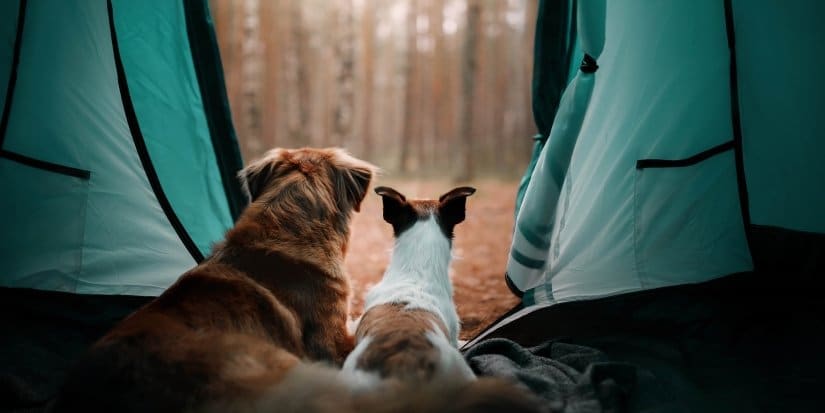
Going camping or hiking alone can be reflective; going with a human companion is exciting. But bringing your furry ball along takes the fun to a more memorable and pleasurable stand. However, there are many things you have to put in place to avoid harming your four-legged in the process. Here they are:
Checklist:
- Meet the vet. Way before the big day, meeting the vet is one of the things to check. You are taking your favorite companion to the wild which is a different setting from the city. There are lots of things that could get to him or her. You have to discuss the area you will be heading to with the vet and find out if your dog is physically prepared, if he or she needs some vaccines and medication, or if their immune system is ready to overcome what the wild has for them.
- Retrain your canine to obey specific instructions. Weeks before the D-day, you have to be sure your dog is going to adhere to your guidelines because the experience you are hoping to realize depends on it.
- Train your dog for the hike. Another thing you need not assume is that your canine friend is built for hiking. Yes, they are animals but have been raised in the city. You should take your dog out for smaller hikes to develop his or her stamina and get used to your desired walking system (booties or natural). You can start with an hour hiking and watch how they respond. Being a hiker, you are probably aware of the rules of the trail. Now is a perfect time to also educate your furry partner how to behave during the trail.
- Know the dangers and prepare against it. There are lots of harm sources in the wild both for you and your dog. Before the journey you have in mind, find out what the location houses from the creatures to the water and plants. Speak to your vet and get what is needed to ensure a safe trip for you and furry companion.
- Get the equipment needed. You are not the only that needs to buy some stuff to observe a successful hike and camping. Your furry partner is also in need of some. Before the d-day it is an excellent idea to purchase a fitted dog pack, first aid kit, towel, collapsible bowls, about six feet leash, flashlights, comb, sleeping blanket and mat, poops bag, feet care, collar with tag, heatstroke prevention system, nail cutter, food, water, and coat if needed.
- Get a sizable tent. Based on the number of people that will be coming for the hike and the number of dogs, see that you purchase the right tent size to accommodate each person perfectly.
- Bring lots of booties. If you decide to train your dog for the trail with a leg protection wear, then you will need several of that for the trip because dogs tend to lose them along the way.
- Get the right meals ready. The journey is going to be exhausting for your canine friend. It is good to pack the right type and amount of food for your furry companion. Usually, what you want to get for him or her is their dry favorite that consists of high proteins and fat. The amount of food you need to bring might vary based on how long and far the hiking entails. But ensure that you add an extra cup on the usual amount you give.
- Bring enough water. The journey is going to be trying for your partner and you. Be sure that you have packed the right amount of water to avoid dehydration. Your large dog can take up to 1 ounce of water and your small ones about 1.5. Based on this, you should decide the quantity that will do for the journey going and returning. Also, ensure that you keep your canine away from stagnant water as they can bring serious harm to his or health.
Best Practices (Hacks!) When Traveling With Your Dog
- Don’t keep your dog at the back of an open truck to avoid fatal incidents.
- Allow your canine to look through the window to make them prone to travel sickness.
- Take a squeegee with you to take care of the shed fur.
- Give your pup an exhausting exercise on the travel day to ensure a peaceful journey.
- Stop the feeding of water and food two hours before the journey to avoid throw ups.
- Wind up the windshield enough to avoid his or her head sticking out without completely closing up to avoid nose injuries for car travel.
- Clean up after your canine partner. Burry a few feet away from a hiking trail without a poop bag. Haul poop bag far away from sight if you use one.
- Bring spares of all the essentials to avoid accidental crises, including their IDs
- Have a GPS for better dog tracking
- Place all the essential documents in a waterproof Ziploc sealed bag for better protection. Don’t forget to put a description of its details on the bag.
- Bring a dryer sheet for storming times to keep him or her calm
- Always keep your canine partner ahead and at sight reach.
- No teasing of Paw friend during the ride to avoid a growl.
- Make the new experience fun with smiles, petting, and that contagious energy.
- Keep the distance from lots of people to avoid overwhelming your pet.
- Get a car seat to keep the fur shedding limited
- Do a better hydration job by bringing the ice cube along.
- Bring some baking soda to reduce pain and swells when needed.
- Ensure your dog is clean and ready to go before the journey
- Leverage the charm and ease of wheels pet travel crates or carriers.
- Don’t forget to bring a chicken broth with low salt to add to his or her water during those moments when they are a little sick.
- Visit petlocation and ask those question you couldn’t get an answer elsewhere.
- Bring your liquid soaps, cotton balls and tweezers for those tick moments.
- Don’t forget the option of a dog sitter for those who really have a bad time traveling via your transport option.
Summary
Traveling and camping with your loyal four-legged companion can be a sight to behold when you observe the right strategy. Here you have it! Your one-stop solution to making your next journey with your furry bestie the best experience yet.
